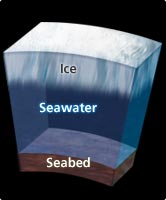Several hundred million years ago the Earth looked absolutely white, not blue like today, when observed from space. The entire Earth was covered in ice and reflected nearly all solar radiation back to space. This “snowball Earth” was responsible for both widespread extinction and macroevolution of living things. Just what kind of phenomenon was it?
Many riddles

Jupiter's moon Europa is named after Zeus's consort in Greek mythology. Zeus is said to have fallen in love with the beautiful Phoenician princess and transformed himself into a white ox to carry her away. According to legend, they traveled all over Europe, which is the origin of the continent's name “Europe”.
©AKG/PPS
Jupiter's moon Europa is covered with a thick layer of ice, under which lies seawater. Scientists believe that Jupiter's gravity causes Europa's ice and rock to twist and deform, resulting in heat friction that melts ice below the surface to form an inner sea. In the past ten years, a series of startling discoveries have suggested that the Earth used to be like Europa, having hidden seawater covered by a thick layer of ice.
We call Earth the "water planet," and its mild climate and liquid water, present over billions of years, were indeed necessary for the evolution of life. Even during the ice age, the cold periods of the glacial ages*1, when the Earth was covered with glaciers, the oceans were never entirely frozen - or at least that's what geologists believed.
- *1An era during which a continent is covered by ice sheets (huge aggregations of glaciers). Presently Greenland and Antarctica are covered in such sheets, and are therefore in a glacial age. Current glacial ages alternate cyclically between cold ice ages and warm interglacial ages.
However, many riddles have long puzzled these same geologists. For example, deposits from the latter half of the Proterozoic era (600 million years ago), including glacial deposits, have been found all over the world. There are other confounding discoveries as well, including special deposits that suggest the oceans were somehow sealed off from the atmosphere for a long period of time, and evidence that shows that at one time there was virtually no life on Earth. What do these facts indicate?
The Earth faces the ever-present danger of being struck by a meteorite or similar object that could cause dramatic atmospheric changes to our planet. The carbon cycle is the reason that a relatively stable temperature has prevailed on Earth. This cycle, which has a direct effect on global temperatures and maintains a balanced climate*2, is further sustained by plate tectonics, the shifting of the great 100 km-thick rock plates that make up the Earth's surface. It is this unique mechanism, which the moon Europa lacks.
- *2Global warming accelerates weathering of the Earth's surface. This results in an increase in CO2 consumption, causing temperatures to drop. On the contrary, declining temperatures cause weathering to slow, decreasing CO2 consumption and increasing temperatures. Thus, the tendency is for the climate to stay balanced.
- Carbon cycle
- Oceanic ridge activity gives rise to plates, upon which deposits are subsumed into the Earth's interior. → Part of the plate is shorn off onto land. → Carbon dioxide (CO2) is released into the atmosphere by volcanoes. → CO2 is dissolved into rain and groundwater and dissolves minerals (weathering). → Carbon ions created through weathering are washed into the sea, becoming carbonate minerals. → CO2 is fixed into organisms through photosynthesis. → Deposits are folded into the Earth's interior again by plate movement.
Evidence of a snowball Earth
Theoretically, there are three stable climactic states: a state with no ice, a state with partial ice at the poles or other locations, and a state in which ice covers the entire Earth, which is referred to as a snowball Earth. Following certain cataclysmic events, the climate can shift rapidly from one stable state to another. The hottest region on Earth is around the equator, so if glacial deposits are discovered there, it is proof that the entire Earth was once frozen. Such hard evidence was found in the late 1980s.
Because of plate tectonics, the continents are constantly moving. However, the original location of glacial deposits can be traced through the direction of paleo-magnetism imprinted in magma or deposits eons ago. However, the direction of this imprinted magnetism is mostly erased when rocks are heated, so a rock's “memory” is often lost permanently. In other words, it is very difficult to determine to which age a rock's magnetism belongs.
However, Professor Joseph Kirschvink of the California Institute of Technology (Caltech) discovered a very special rock with exposed glacial deposits from the latter half of the Proterozoic era in the Elatina Formation in southern Australia. The extremely folded specimen was tested and revealed that the paleo-magnetism present in the rock followed the folds, meaning that the original magnetic imprint was still intact. The magnetic pattern revealed that the rock had originally been deposited around the Earth's equator, showing that glaciers had definitely stretched as far as the equatorial region.
In 1992, Kirschvink pointed out that an Earth completely covered in ice would explain why glacial deposits were found all over the world and certain banded iron formations exist. When Kirschvink announced his snowball Earth hypothesis in a brief two-page paper, hardly anybody noticed.
From blue to white and back again
How could the snowball Earth come about?
Constant variations in volcanic activity mean that the amount of carbon dioxide (CO2) released by volcanoes into the atmosphere also varies. Eiichi Tajika, an associate professor at the University of Tokyo, hypothesizes that “a snowball Earth event could appear if volcanic activity ceased and the amount of carbon dioxide in the atmosphere declined to one-quarter of current levels, while remarkably decreasing the greenhouse effect.”
The shift to a snowball Earth would cause the average surface temperature to fall to -40°C. The oceans would freeze to a depth of about 1,000 meters, where frozen seawater and heated currents from undersea vents would meet.

During a snowball Earth event the seas freeze to a depth of 1 km over the course of about 100,000 years. Heat flows on the ocean floor prevent deeper freezing.
The ratio of how much solar radiation is reflected from the Earth or its atmosphere is called planetary albedo. A snowball Earth event would appear when the albedo increased from 0.3 to 0.7, where nearly all radiation from the sun is reflected back to space. Once shifted to this state, the reflective white surface of the Earth would absorb so little solar energy that the frozen state would be very hard to break out of. A significant amount of carbon dioxide would need to be accumulated in the atmosphere to kick-start the greenhouse effect, but a snowball Earth would mean no rain and frozen oceans, so the carbon cycle would lie dormant. However, plate tectonics would insure that volcanic activity would begin, contributing to supplying the atmosphere with carbon dioxide.
Over several million years, enough carbon dioxide would have accumulated in the atmosphere to reach an atmospheric pressure of 0.1 atm, at which point the temperature would have risen high enough to begin melting sea ice. The powerful greenhouse effect by carbon dioxide would have rapidly pushed temperatures up to over 50°C. It is believed that snowball Earth events occurred repeatedly during the Proterozoic era. When viewed from space, the Earth would have alternated in color from blue to white to blue again.
- A process of partially to totally frozen Earth
- A totally frozen Earth is white and therefore reflects radiation from the sun.
Snowball Earth events are thought to have occurred repeatedly 2.2 billion, 750 million, and 600 million years ago.
From massive extinction to the macroevolution of living creatures
On a totally ice-covered “snowball Earth”, massive extinction of living creatures would have precipitated. This assumption comes from deposits found in an era during which a snowball Earth event occurred. In this period, an unusual pattern of variation in the ratio of carbon isotopes in deposits was markedly shown.
In nature, there are two kinds of isotopes of carbon (carbon-13 and carbon-12). When living organisms perform photosynthesis in the air they tend to absorb more of lighter and easy-to-uptake carbon-12 than carbon-13. However, no trace of the absorbing light carbon-12 was found in deposits in the time of snowball Earth. This means that no biogenic activity was recognizable during this period. When Paul Hoffman, Professor at Harvard University, pointed out this hypothesis in 1998, the idea of snowball Earth attracted people's attention and discussions about it began in earnest.
However, there remained some important questions. For example, how and where on Earth did the living organisms that eventually led to human beings successfully survive? And, in particular, how could eucaryotes*3 survive in such difficult conditions? It is currently believed that living organisms must have survived around vents where water heated by volcanic activity streamed out.
- *3Organisms with nucleated cells. Includes animals, plants, fungi, and protists.
Shortly after the snowball Earth period, ediacaran organisms appeared. The flat, shell-less organisms had almost totally disappeared when the Proterozoic era ended and the Cambrian era began. However, in the Cambrian period, a huge surge in the diversity of living creatures, known as the Cambrian Explosion*4, took place. It is thought that the massive extinctions caused by the snowball Earth event actually paved the way for the macroevolution that followed.
- *4A sudden proliferation of species in which 32 currently existing phyla appeared. Humans belong to the Vertebrata subphylum in the Chordata phylum.
The “light-reflective star” saw both extinction and evolution on a grand scale, after which living creatures took their next significant steps. In the next story, “Life that glows in the sea,” we will describe the link between light and animals.
Editorial contributor
Associate Professor Eiichi Tajika of the University of Tokyo

